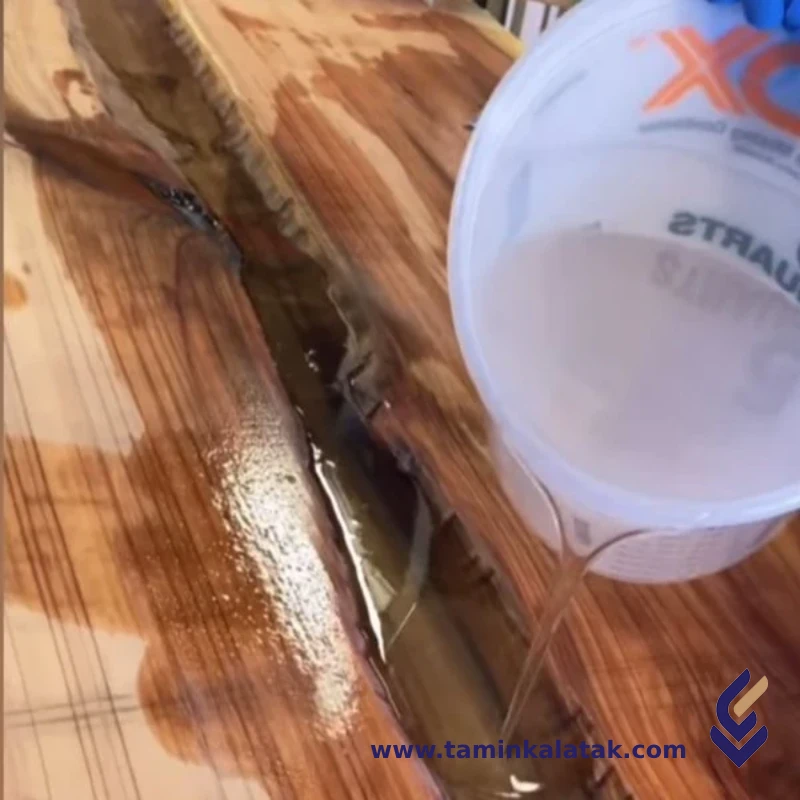Polymers are made up of very large molecules made up of many repeating units called monomers, which ultimately form this long polymer chain
A compound is a polymer blend mixed with additives, fillers, and reinforcements to achieve specific properties for end-use applications. A masterbatch is a concentrated mixture of additives or pigments in a carrier resin, used to enhance plastics without altering their base properties.
Epoxy Resins (EP)
Epoxy resins (EP) are a class of thermosetting polymers known for their excellent mechanical properties, chemical resistance, and strong adhesion to various substrates. They are widely used in industries such as construction, aerospace, automotive, electronics, and coatings.
Structure Epoxy resins
Epoxy resins typically feature a molecular structure characterized by reactive epoxide groups, which are three-membered cyclic ethers with significant strain energy. In many commercial systems, these resins are produced by reacting bisphenol A with epichlorohydrin, yielding a diglycidyl ether that contains two epoxide groups attached to an aromatic backbone. This structure enables efficient crosslinking with various hardeners such as amines or anhydrides during the curing process. The resulting three-dimensional network of interlinked polymer chains is what imparts epoxy resins with their high mechanical strength, excellent chemical resistance, and durable performance in demanding applications.
Properties Epoxy resins
Epoxy resins are valued for their robust mechanical strength and chemical resistance, combined with low shrinkage during the curing process. Their ability to firmly adhere to a variety of substrates, including metals, glass, and concrete, makes them particularly useful in structural and industrial applications. In addition, these thermosetting polymers exhibit excellent electrical insulation properties, ensuring their suitability for electronics and electrical encapsulation. Their high durability and resistance to environmental degradation further contribute to their performance in demanding conditions, and their properties can be tailored through the incorporation of additives or fillers to achieve specific performance criteria.
Applications Epoxy resins
- Used as structural adhesives in aerospace, automotive, and construction industries
- Applied as protective coatings in industrial floors, marine environments, and chemical storage facilities
- Employed in composite materials reinforced with carbon or glass fibers for lightweight, high-strength applications
- Utilized for electronic encapsulation, potting, and PCB manufacturing due to its excellent electrical insulation properties
- Incorporated in construction materials such as grouts, sealants, and repair mortars
- Adopted in art and decorative projects, including resin art, jewelry, and tabletops
Advantages Epoxy resins
- Offers high mechanical strength and durability in demanding applications
- Provides excellent chemical and corrosion resistance, ensuring longevity
- Exhibits low shrinkage during curing, resulting in dimensional stability
- Delivers strong adhesion to a wide range of substrates, from metals to plastics
- Functions as an effective electrical insulator, ideal for electronic applications
- Allows for property customization through additives and fillers
Disadvantages Epoxy resins
- Can be brittle in some formulations, often requiring modification with toughening agents
- Presents potential toxicity during handling, necessitating proper safety precautions
- Generally higher in cost compared to alternative resins like polyester or vinyl ester systems
- Curing conditions can be sensitive to environmental factors, affecting final performance
- May exhibit limited UV resistance, often needing additional protective coatings for outdoor use
Applications
| Applications | , , , , |
|---|
(EP) Epoxy resins
| Products | Grade | Density (g/Cm3) | viscosity(mPa.s) | Applications | Data Sheet | MSDS |
|---|---|---|---|---|---|---|
| Epoxy resin | Bisphenol A | 1.15-1.20 | 10,000-15,000 | aerospace, automotive,construction Protective coatings Matrix material in composite systems Electronic encapsulation, potting Sealants, grouts, repair mortars Decorative and artistic resin casting | ||
| Epoxy resin | Bisphenol F | 1.15-1.20 | 12,000-20,000 | High-performance coatings Structural adhesives for automotive, aerospace,construction sectors Matrix systems in fiber-reinforced composites Molding, casting |










